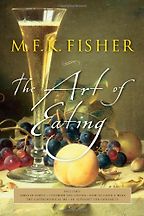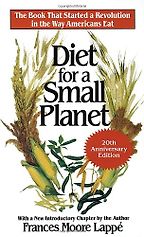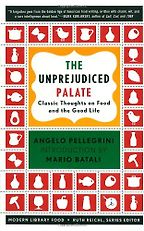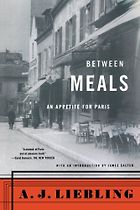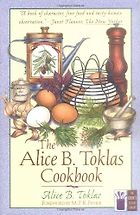Three of the books you’ve chosen are heavily focused on, and influenced by, France. One is by an Italian immigrant. Isn’t our topic American food?
I do think of these very much as American food books. American food is the food of immigrants. You go back a couple of hundred years and we were all immigrants, unless we’re going to talk about Native American cuisine. And for much of the early part of the 20th century, Americans were slavishly following French cooking. So it’s not an accident that Alice B Toklas and AJ Liebling were focused on France.
Why did people slavishly follow French cuisine?
I think it’s because if you go back to the roots of America, we were founded by Puritans who had no pleasure in food. There is an almost anti-epicurean tradition at the very base of America. For much of the middle part of American history, people who wanted to overcome that went to France. For me, what’s exciting about what is happening today in food is that we’re finally embracing America. We have become a food culture, but we very much were not. So you have someone like [Angelo] Pellegrini. I find him remarkable. His book was actually written the year I was born [1948]. He has what I now consider a modern American aesthetic of food. But people in America weren’t thinking like that in 1948. It was a culture of hamburgers and frozen food. The industrialisation of food was just about to start. And here you have this man saying, “Wait a minute! Why are you spending all this time on your lawns? Pull them up! Plant some food!”
“America, we were founded by Puritans who had no pleasure in food. There is an almost anti-epicurean tradition at the very base of America.”
Yes, I noticed the references to tinned or canned vegetables in some of the books you chose.
In the middle of the 20th century, that what’s American food was! Canned food, frozen food and then 10 years later you get the “I hate to cook” book. Then the women’s movement came in and there was a whole backlash against cooking. If you’re going to look for people who cared about food at that particular point, you have MFK Fisher going to France and discovering food. She was brought up in a Quaker town.
Shall we start with her book then? You’ve chosen a collection of five of her shorter books called The Art of Eating. It’s part memoir, part musings on food.
MFK Fisher was a wonder and a huge influence, and someone I got to know pretty well at the end of her life. She had this epiphany when she went as a young bride to France and discovered food – to me, in the best possible way – and brought that back to America. What I love about her is that she’s really a wonderful writer. She’s very thoughtful about the subject of food – it’s a subject that she embraces and takes on. For someone like me, growing up in the 1950s, if you wanted to read this kind of stuff about food, there wasn’t anybody else.
I read the chapter “Consider the Oyster” last night, from 1941. Were Americans generally not eating oysters at that time?
If you go back in American history, oysters were the food of poor people. New York was filled with oyster saloons in the 1800s. They were so abundant and so plentiful that we ate them all up – and they went from being the food of the poor to being almost impossible to find.
Although there are recipes in it, it’s not a cookbook is it?
No, it’s a book about taking pleasure in food.
Tell me about Between Meals. This is by AJ Liebling and it’s mainly about him enjoying being a glutton in Paris restaurants before World War II.
This is the male version [of the MFK Fisher]. To me, they have always walked hand in hand, Mary Frances and AJ. What I love is the contrast to Mary Frances. He is an unabashed glutton. His famous phrase is that the primary requisite for writing well about food is a good appetite. But what he is not saying is that, really, the primary requisite for writing well about food is the ability to write. He had both. He’s such a beautiful writer that you can pick this book up at any point and there’s something wonderful that you want to quote. It’s an old man’s yearning for the joys of his youth. It’s also about women – that wonderful last chapter, “Passable”. It’s about being able to appreciate the small things in life. For me, all these books – with the exception of Diet for a Small Planet – are really an exhortation to pay attention to the little things in life, to get pleasure out of this thing we all do every day, three times a day. That’s what attracts me to them.
Liebling rues the changing attitudes towards food, doesn’t he? Before, if a businessman wasn’t fat, you’d think he was doing badly. Sport was considered an eccentricity. The fact that by the time he’s writing, people are trying to be thin and are exercising – Liebling finds that pretty upsetting.
Yes. He talks about how much he loved Paris in the 1920s, but he later finds out that in fact he missed the golden age, which was before World War I. He laments that he didn’t get to see that. There’s also a wonderful passage in there about how glad he is that he didn’t have a lot of money. When I first read it, I didn’t have any money either. Liebling did not go to Paris as a rich person, eating three-star meals, and he says that helped his appreciation. That’s an important point. This isn’t about eating caviar and truffles. MFK Fisher does a whole passage on eating a tangerine. It’s one of the most beautiful passages in food writing – about taking these sections of tangerine and putting them on the radiator, until they almost crystallise on the outside, and the burst of flavour, the warm juice in your mouth. That’s a very important thing to me. You don’t have to be rich to eat well.
I was also struck by the range of food – he talks about eating tripe and woodcock. It seems that in the past we were much more adventurous about what we ate.
The person to go to for that is really Pellegrini, who goes on and on about offal and eating the guts of chickens and is appalled by what Americans don’t eat.
Yes, I think a promising relationship with a girl ends because he shoots some larks with his slingshot on her parents’ estate and cooks them.
Yes, and he trapped rabbits. There’s also a wonderful passage about his father taking the intestines of chickens and washing them very carefully and leaving them to soak overnight. His Sunday morning ritual was cutting them into little pieces and frying them crisp and then folding them into an omelette. He talks about how Americans won’t eat these things. It’s still one of the really high hurdles for Americans. I happen to love tripe, but getting Americans to eat tripe or kidneys or even sweetbreads… When I was at Gourmet, we once counted how many offal recipes there were in the 1940s. There were lots of them. In our last year [2009], I think we printed just two.
The third book on your list is Diet for a Small Planet. This is more about social action, changing the world by changing the way you eat, and the politics of food.
This book was a real game-changer for my generation. When I read that book, I had not thought about any of these things – the fact that we were feeding 20 pounds of useable protein to a steer, to get one pound of useable beef. It absolutely galvanised me and many people like me. It’s a book that was ahead of its time, the kind of thing people are doing now, and thinking about now. But when this book came out in the early 1970s, it was revolutionary. I feel this is a book that hasn’t gotten its due. It was very important for the Berkeley Food Movement – so much of it came out of Frances Moore Lappé, who brought the politics of food to the attention of the anti-war generation. I think it was, in many ways, responsible for much of what happened later. And it’s a cookbook.
Yes, a meatless cookbook, which she distinguishes from a vegetarian one.
Exactly, and it’s definitely not vegan. To me it’s really interesting to take stock and look at where we were – this was almost 40 years ago – and how much things have changed. People are much more aware now. Her recipes are very fat-heavy, very dependent on cheese and eggs. Probably if she were doing those recipes today, they would be vegan.
Why do you say that?
Because these days many of the young people who are food activists tend to be vegan. I don’t know this for a fact, but my instinct is that a modern version of the book would be vegan.
In terms of taking stock, I watched Food, Inc a few weeks ago. When I read Diet for a Small Planet, I thought, “Wow, she’s talking about pretty much the same thing.” The big agricultural companies, like Cargill, are still the bad guys. She said all this in the 70s and we’re still watching documentaries about it now. How much progress have we made?
In fact things have got worse. She was the canary in the mine. We didn’t pay enough attention. The industrialisation of food and the vertical integration of agriculture just galloped forward. She’s not even talking about things like confinement animal facilities. The difference is that the political food movement was a fringe movement in 1970 and now it’s very mainstream. Frances Moore Lappé was sounding a call to battle which was not picked up for three decades. So now you have people like Michael Pollan and Eric Schlosser saying, “Wait a minute! It’s time we really started taking a look at this!” And their timing was right. People were ready to hear it.
Her criticism of the industry is political, but she’s also saying that the American obsession with meat is plain unhealthy. She writes, “The typical American diet is a high-risk diet.” I also like her point that eating more vegetables and less meat liberated her from “from the stifling preoccupation with weight that plagues so many Americans”.
It’s remarkable. This book was written before the obesity crisis, before the diabetes crisis. The American government policy on what we supported and subsidised in agriculture was a social experiment on a whole generation of children. Now we’re paying the price for that. She pointed out we were going to have problems and we do. She says eat a plant-based diet, it’s better for you. Forty years later Michael Pollan writes Food Rules and says essentially the same thing.
I particularly like the chapter “Who asked for Fruit Loops?” Even my kids find that particular breakfast cereal too disgusting to eat.
Good for them! I have to admit I’ve never had a Fruit Loop. Are they really loathesome?
Just this yucky artificial taste and colouring. But I think the problem is that once you develop a taste for these kind of unhealthy things, then you crave more of them. My guess is that people suffering from obesity have grown up eating very processed foods like doughnuts, so that’s what they want to eat.
I don’t know. If you really taste a doughnut, it’s pretty disgusting. They taste of grease. I bought one a couple weeks ago – I hadn’t had one in a really long time. I thought the only way you can really eat this is if you’re not paying attention. The same goes for Coca-Cola. If you really taste it, if it’s not ice cold, I don’t think anyone could get it down. I think part of what happens is that if you start training yourself to actually taste food, you turn away from a lot of stuff.
Is there a recipe in the book you want to recommend?
A lot of the recipes are actually quite nice. There’s one called “Rice con queso” that I haven’t had in years, but I used to love it. Rice and beans and cheese and ricotta. It was pretty heavy – I would probably modify it now – but we used to make it all the time in the 1970s. I can taste it in my mind. Delicious.
So are you off dairy products or trying to cut back on them?
Oh God no! Are you kidding? I couldn’t live without butter. Butter is probably my single favourite food. No, not at all.
Tell me about The Alice B Toklas Cookbook and why you chose it.
If you ask most people about the Alice B Toklas cookbook, the recipe that comes immediately to mind is marijuana brownies. It needs to be rescued from that. One of the things that I love about this book is the wonderful way she writes the recipes. If you’re used to Elizabeth David, it’s not so strange, but if you’re used to most American recipes, there is something lovely and conversational about them. I wanted to include a book that had really good recipes. I defy anyone to read this and not get hungry, and not want to go into the kitchen and start cooking. It’s just a wonderful ode to food, and a cookbook. It’s one of the first cookbooks that I really sat down and read and found myself cooking from, as a kid. So it’s important to me that way. But again, it’s one of these books that’s about appreciating life, eating everything and living with the seasons. As a kid, when I read it, I thought, “Why isn’t my life more like this?” This is a book that, again, I feel has been unfairly overlooked and is a great ode to the fact that there were Americans who loved food even in the 1950s.
It doesn’t go into great detail, but it does also convey some sense of Alice Toklas’s life with Gertrude Stein, hanging out in Paris with famous artists. For example, she has ‘‘Bass for Picasso” in there as one of her recipes. He had some specific dietary requirements I think.
Yes, it’s what Picasso likes. If you’re feeding artists, you have to feed them well.
Get the weekly Five Books newsletter
And she talks about the American habits she brings to France, like eating in the kitchen rather than always having to bring things through to a formal dining room.
Yes, but that’s not really American, it’s kind of bohemian, which is another reason that I love the book. It’s this conjunction of formality of food with a casualness in the way it’s served. In the 50s in America, there were a lot of rules about how you ate and how the table was set. In the book, there is a lot of thinking about how you’re setting the table, where you’re eating, picnics and so forth. Again, a kind of, let’s appreciate it, and think about how we’re going to sit down at the table. There is a lot of throwing out the rules – which, for me, is an important part of cooking and eating.
Do you want to recommend one recipe in there?
I could probably open the book at any point and find a recipe I really love. Let’s see… her way of scrambling eggs [Oeufs Francis Picabia, named after the artist] is perfect. She does it in a double boiler so it is never directly on the heat and it’s very slow, but it’s fantastic.
We’ve already referred to it a number of times, so hopefully we’ve built up to a grand finale: Angelo Pellegrini’s book The Unprejudiced Palate. He was a very poor immigrant from Italy – as a boy he collected manure in the streets. Then he came to America, and was struck by the abundance of his new home.
Pellegrini is, in many ways, my hero. He’s such an advocate for paying attention to life. There is a point where he says what a lost opportunity it is if you bring someone in to do your cooking or your gardening. There’s real joy to be found in doing these things for yourself. The pride in making your own wine, growing your own food, sitting down at the table and serving people something that is really the fruit of your own hands. He has this connection to the earth, and at the same time he’s an intellectual. His lectures on Shakespeare were legendary. I’ve actually met his granddaughter. They’re a wonderfully close-knit family. To me, it’s the ideal life.
He makes it all sound so easy as well. After reading it, I was ready to go down to the cellar and start making my own wine.
He does. We’re all addicted to leisure. We all want to sit and watch TV at night or whatever. He’s making bread or is out in the garden. He’s not wasting one minute of his life.
It is a whole philosophy he’s presenting – cultivating your garden is how to lead the good life. “This is a way to be happy,” he says at one point. It’s much more than just a book about food.
It is. It’s called The Unprejudiced Palate, but in fact it’s the most prejudiced palate that ever walked the earth. The idea that this book came out when it did [1948], and that he was living like this, in a city [Seattle], is remarkable to me. It was so against the grain of American life in the 1950s. People didn’t live like that then. Lots of people are trying to live like that now, but he really was out of step at that point, but held on to his convictions.
He complains about a few things that also irk me. American bread and the tastelessness of the fruit – it’s picked too soon so that it can be transported.
But now you can get good bread! In those days you couldn’t. But yes, if you want an apple, unless you have a farmer’s market, you’re probably getting apples that were picked a year ago in China. They’re either Delicious or McIntosh, which can be picked green, ripened with ethylene and left forever. It was starting when Pellegrini was writing and it got worse.
He also argues that immigrants have better food than Americans.
That tends to be true until they adopt the American diet. When they get enough money suddenly they’re eating at McDonalds instead.
I was tempted by quite a few of his recipes.
His recipes are terrific. You could pick just about any recipe in the book. One thing he makes a huge push for is eating the kinds of greens, the bitter greens, that Americans tend not to like – so he has recipes for cardoons and chicory and dandelion greens, all of which are terrific. Any of the pasta dishes he talks about are really good. I find all his recipes just really, really inspiring. I was talking earlier about the omelette with intestines. I desperately want to make that now.
He has a recipe for potatoes to go with steak or salad that I was tempted to make immediately. He makes it all sound very simple. I’m sure it’s a bit harder in practice.
I don’t think so. I think they are easy. My basic belief is that cooking is easy. We’ve made it complicated, because everybody wants to be able to make everything. But if you’re not demanding of yourself that you make chef-quality food, or that you know everything about French, Chinese, Japanese and Indian cuisine, cooking is what we do naturally.
November 8, 2012. Updated: November 15, 2022
Five Books aims to keep its book recommendations and interviews up to date. If you are the interviewee and would like to update your choice of books (or even just what you say about them) please email us at [email protected]
Five Books interviews are expensive to produce. If you've enjoyed this interview, please support us by donating a small amount.
